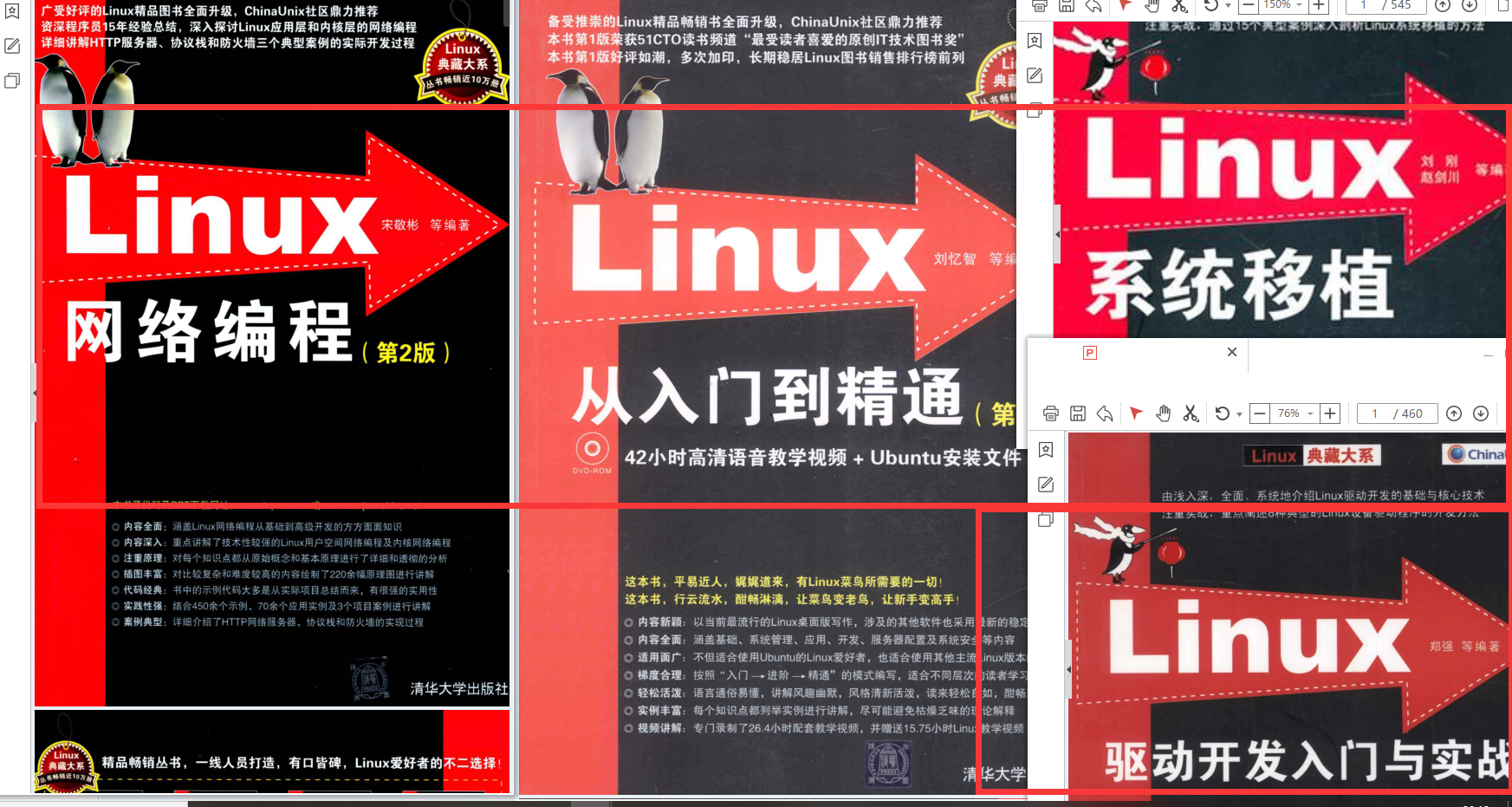
最全的Linux教程,Linux从入门到精通
======================
-
linux从入门到精通(第2版)
-
Linux系统移植
-
Linux驱动开发入门与实战
-
LINUX 系统移植 第2版
-
Linux开源网络全栈详解 从DPDK到OpenFlow

第一份《Linux从入门到精通》466页
====================
内容简介
====
本书是获得了很多读者好评的Linux经典畅销书**《Linux从入门到精通》的第2版**。本书第1版出版后曾经多次印刷,并被51CTO读书频道评为“最受读者喜爱的原创IT技术图书奖”。本书第﹖版以最新的Ubuntu 12.04为版本,循序渐进地向读者介绍了Linux 的基础应用、系统管理、网络应用、娱乐和办公、程序开发、服务器配置、系统安全等。本书附带1张光盘,内容为本书配套多媒体教学视频。另外,本书还为读者提供了大量的Linux学习资料和Ubuntu安装镜像文件,供读者免费下载。

本书适合广大Linux初中级用户、开源软件爱好者和大专院校的学生阅读,同时也非常适合准备从事Linux平台开发的各类人员。
需要《Linux入门到精通》、《linux系统移植》、《Linux驱动开发入门实战》、《Linux开源网络全栈》电子书籍及教程的工程师朋友们劳烦您转发+评论
网上学习资料一大堆,但如果学到的知识不成体系,遇到问题时只是浅尝辄止,不再深入研究,那么很难做到真正的技术提升。
一个人可以走的很快,但一群人才能走的更远!不论你是正从事IT行业的老鸟或是对IT行业感兴趣的新人,都欢迎加入我们的的圈子(技术交流、学习资源、职场吐槽、大厂内推、面试辅导),让我们一起学习成长!
public interface BlockingQueue<E> extends Queue<E> {
//将指定的元素添加到对列中,如果队列容量未满。如果满了,抛出异常
boolean add(E e);
//如果可以在不违反容量限制的情况下立即将指定元素插入此队列,则在成功时返回 true,如果当前
//没有可用空间则返回 false。 当使用容量受限的队列时,这种方法通常比 add 更可取,它可以仅通
//过抛出异常来插入元素失败。
boolean offer(E e);
//将指定的元素插入此队列的尾部,如果该队列已满,则一直等到(阻塞)。
void put(E e) throws InterruptedException;
//带有等待时间的入队方法
boolean offer(E e, long timeout, TimeUnit unit)
throws InterruptedException;
//获取并移除此队列的头部,如果没有元素则等待(阻塞),
//直到有元素将唤醒等待线程执行该操作
E take() throws InterruptedException;
//与offer对应
E poll(long timeout, TimeUnit unit)
throws InterruptedException;
//查看队列还有的容量
int remainingCapacity();
// 删除操作,与add对应
boolean remove(Object o);
public boolean contains(Object o);
int drainTo(Collection<? super E> c);
int drainTo(Collection<? super E> c, int maxElements);
}
查看接口的继承关系图

接下来我们重点介绍 ArrayBlockingQueue、LinkedBlockingQueue、LinkedBlockingDeque
ArrayBlockingQueue的源码解析
public class ArrayBlockingQueue<E> extends AbstractQueue<E>
implements BlockingQueue<E>, java.io.Serializable {
//队列底层容器
final Object[] items;
/** 下一个 take, poll, peek or remove的数组下标位置 */
int takeIndex;
/** 下一个 next put, offer, or add的数组下标位置 */
int putIndex;
/** 数组的已有数量 */
int count;
/** 队列锁******/
final ReentrantLock lock;
/** 获取队列数据的的condition等待队列 */
private final Condition notEmpty;
/** 存入队列数据的condition 等待队列*/
private final Condition notFull;
transient Itrs itrs = null;
//队列构造方法必须指定大小,有界队列
public ArrayBlockingQueue(int capacity) {
this(capacity, false);
}
// boolean fair ture为公平锁,严格的按照FIFO的原则获取锁,默认非公平锁
public ArrayBlockingQueue(int capacity, boolean fair) {
if (capacity <= 0)
throw new IllegalArgumentException();
this.items = new Object[capacity];
lock = new ReentrantLock(fair);
notEmpty = lock.newCondition();
notFull = lock.newCondition();
}
代码省略。。。。。。。。
}
接下来看源码分析ArrayBlockingQueue是如何对队列进行add-remove put-take offer-poll
//add方法实际是调用的offer方法如如果成功返回true 否则抛出异常
public boolean add(E e) {
return super.add(e);
}
public boolean offer(E e) {
//检查传入的数据是否为空
checkNotNull(e);
// 定义锁 final变量,构造器类初始化的时候就已经申请好,state变量初始化好内存。
final ReentrantLock lock = this.lock;
lock.lock();
try {
//判断当前的count是否等于数组的容量
// 是返回fasle 否则加入到队列中
if (count == items.length)
return false;
else {
enqueue(e);
return true;
}
} finally {
lock.unlock();
}
}
private void enqueue(E x) {
final Object[] items = this.items;
// putIndex 入队的下一个数组下标值
items[putIndex] = x;
//需要将putIndex重新设置为0,这是因为当前队列执行元素获取时总是从队列头部获取,而添加元素从中//从队列尾部获取所以当队列索引(从0开始)与数组长度相等时,
if (++putIndex == items.length)
putIndex = 0;
count++;
//当队列数据不为空时唤醒取数队列的等待condtion表示可以去获取数据了
notEmpty.signal();
}
public void put(E e) throws InterruptedException {
checkNotNull(e);
final ReentrantLock lock = this.lock;
//中断锁。当前线程可以响应中断 中断后,抛出异常
lock.lockInterruptibly();
try {
while (count == items.length)
//当队列满了以后,那么入队的condition等待队列 等待,将该线程加入的等待队列中
notFull.await();
//否则入队操作
enqueue(e);
} finally {
lock.unlock();
}
}
LinkedBlockingQueue的源码解析
public class LinkedBlockingQueue<E> extends AbstractQueue<E>
implements BlockingQueue<E>, java.io.Serializable {
//存储数据的节点
static class Node<E> {
E item;
Node<E> next;
Node(E x) { item = x; }
}
/** 容量大小 默认为 Integer.MAX_VALUE */
private final int capacity;
/** 当前队列的数量 */
private final AtomicInteger count = new AtomicInteger();
//头节点
transient Node<E> head;
//尾节点
private transient Node<E> last;
/** 取数据锁对象 */
private final ReentrantLock takeLock = new ReentrantLock();
/** Wait queue for waiting takes */
private final Condition notEmpty = takeLock.newCondition();
/** put数据锁对象 */
private final ReentrantLock putLock = new ReentrantLock();
/** 等待队列条件 */
private final Condition notFull = putLock.newCondition();
由上面的LinkedBlockingQueue源码可以分析到 LinkedBlockingQueue 是一个基于链表的阻塞的无边界的队列。默认的队列容量为Integer.MAX_VALUE 当然这样容易引发的问题,当入列速率远超过出队速率时,可能会造成内存溢出、即超出容量的最大值。另外ArrayBlockingQueue入队与出队只有一把锁。但是LinkedBlockingQueue入队和出队是不同的锁对象、提高了队列的吞吐量
public boolean offer(E e) {
if (e == null) throw new NullPointerException();
final AtomicInteger count = this.count;
if (count.get() == capacity)
return false;
int c = -1;
Node<E> node = new Node<E>(e);
final ReentrantLock putLock = this.putLock;
putLock.lock();
try {
if (count.get() < capacity) {
enqueue(node);
c = count.getAndIncrement();
if (c + 1 < capacity)
// 如果容量还够。唤醒入队的condtion去写入数据
notFull.signal();
}
} finally {
putLock.unlock();
}
if (c == 0)
// 如果容量为0表示队列还有一条数据 (原来的值为-1) 。唤醒入队的condtion去写入数据
signalNotEmpty();
return c >= 0;
}
take阻塞获取的方法
public E take() throws InterruptedException {
E x;
int c = -1;
//获取当前队列大小
final AtomicInteger count = this.count;
final ReentrantLock takeLock = this.takeLock;
takeLock.lockInterruptibly();//可中断
try {
//如果队列没有数据,挂机当前线程到条件对象的等待队列中
while (count.get() == 0) {
notEmpty.await();
}
//如果存在数据直接删除并返回该数据
x = dequeue();
c = count.getAndDecrement();//队列大小减1
**网上学习资料一大堆,但如果学到的知识不成体系,遇到问题时只是浅尝辄止,不再深入研究,那么很难做到真正的技术提升。**
**[需要这份系统化的资料的朋友,可以点击这里获取!](https://bbs.youkuaiyun.com/topics/618635766)**
**一个人可以走的很快,但一群人才能走的更远!不论你是正从事IT行业的老鸟或是对IT行业感兴趣的新人,都欢迎加入我们的的圈子(技术交流、学习资源、职场吐槽、大厂内推、面试辅导),让我们一起学习成长!**
























 1410
1410

 被折叠的 条评论
为什么被折叠?
被折叠的 条评论
为什么被折叠?








